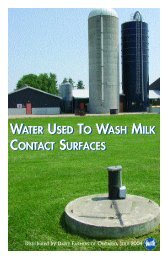Canadian Quality Milk On-Farm Food Safety Program - Centre ...
Canadian Quality Milk On-Farm Food Safety Program - Centre ...
Canadian Quality Milk On-Farm Food Safety Program - Centre ...
You also want an ePaper? Increase the reach of your titles
YUMPU automatically turns print PDFs into web optimized ePapers that Google loves.
<strong>Canadian</strong> <strong>Quality</strong> <strong>Milk</strong><br />
animals are milked last into the milkline, make sure the milk delivery line or transfer<br />
line is taken off the bulk tank before milking them.<br />
Establish a routine for handling abnormal milk from animals that cannot be<br />
segregated.<br />
Clean, check and maintain an extra milking unit used for milking animals with<br />
abnormal milk. Maintain these units in the same manner as the other units.<br />
If the animal has not been treated, use a quarter milker to discard the milk from<br />
a single infected quarter. This allows you to improve milk quality without having to<br />
discard too much milk.<br />
Clearly identify animals infected with contagious bacteria (e.g., Strep. agalactiae and<br />
Staph. aureus) and milk them separately to prevent the spread of contagious<br />
diseases to other animals. If possible, designate one milking unit for milking infected<br />
animals or milk them last.<br />
After milking an animal with contagious bacteria, disinfect the unit by:<br />
• Automatic back-flushing.<br />
• Manually disinfecting each unit. The recommended method for manual<br />
disinfecting is:<br />
− First, rinse both the exterior and interior of the unit.<br />
− Next, dip the claw in a sanitising solution containing 25-50 ppm of iodine ⎯<br />
ensure solution stays in contact with interior of claw for 30 seconds.<br />
− Finally, rinse the claw and let it drain.<br />
Whenever possible, milk cattle with a doubtful status, such as purchased<br />
replacement and high SCC cows, after the healthy animals and before the infected<br />
ones. This will reduce the risk of spreading a contagious infection.<br />
Whenever possible, milk early lactation cattle before late lactation cattle, as they are<br />
less at risk of being infected by a contagious microorganism.<br />
5.2.3 <strong>Milk</strong>ing Treated Animals<br />
<strong>Milk</strong>ing is a Critical Control Point on a dairy farm because it is the last step in the<br />
process of producing milk where you can prevent treated milk from entering the bulk<br />
tank. When milking, you must ensure that milk from treated animals that have not met<br />
appropriate withdrawal times is not shipped for human consumption. Never use quarter<br />
milkers on a treated animal. Antibiotics can be released into the milk regardless of the<br />
site of entry.<br />
Critical Control Point: <strong>Milk</strong>ing treated animals<br />
Hazard: Chemical: pharmaceuticals (e.g. antibiotic residues)<br />
Critical Limit: Negative by a recognized test by the provincial regulatory authority.<br />
5—8<br />
June 2010
















